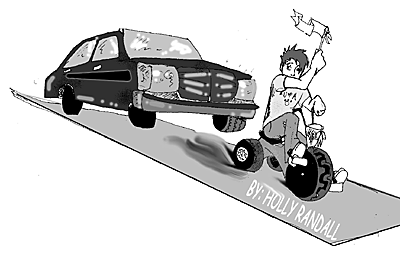
Illustration by Holly Randall
|
|
By Dillon Fishman
Arizona Daily Wildcat
Tuesday, February 8, 2005
Print this
Last month, the Wildcat reported a hit-and-run accident that resulted in the death of Colin Griswold, a UA doctoral student.
While the event brought sadness to the lives of many, it should, more than anything, be a signal that the UA needs to do more to address traffic safety issues.
Traffic accidents and police vehicle stops occur regularly on Speedway Boulevard, Campbell Avenue, Euclid Avenue and Sixth Street, all of which immediately border the University. Orange and white barricades often signal construction on and around those same streets. The combination of foot and bike traffic, construction, busy streets and Tucson motorists is a recipe for an accident.
A good place for the UA to begin responding to this issue is to call a round-table forum with, at a minimum, representatives from the City Council, Tucson Police Department, University of Arizona Police Department, and Associated Students of the University of Arizona. They should then develop a standing committee to regularly review and update traffic safety protocol on and around the UA. And much work remains to be done.
For instance, in most school zones, bright traffic signs and flashing lights alert drivers and pedestrians to the risk of accidents, regulate traffic and caution them to be aware and to slow down. However, most of the streets surrounding the UA lack even such basic preventative safety equipment. Nor has the city lowered the traffic speed limit on streets surrounding the UA.
A few years ago, Arizona State University had a similar problem. Freshman Jessica Woodin died after being reportedly propelled 300 feet from a speeding Mustang. Realizing that traffic safety around campus needed improvements, ASU responded by working with local organizations to make traffic safer.
ASU responded by installing new traffic signals, bright neon signs and flashing lights on some of the busiest streets around campus. Tempe Police also coordinated efforts with ASU, heavily targeting speeding motorists and enforcing traffic laws around the campus. Drivers quickly learned that speeding on or near ASU's campus was a mistake. UA administrators and TPD should follow the example.
There is another incentive for UA administrators to address traffic safety issues-avoiding potential liability. The UA's lack of safety devices could result in a large award in a lawsuit. One doesn't need a crystal ball to understand that the chances of an accident are high, given all of the above risks. And if a pedestrian is killed or injured by an automobile, it seems unlikely that a jury would sympathize with the UA, knowing that many of the precautionary devices such as bright signs and flashing lights could probably be installed at minimal cost.
The liability probably wouldn't stop with the UA administration, either. If that lawsuit came, the city would likely be added as a party for its failure to take some obvious precautions. For example, several of the traffic lights along Speedway Boulevard - such as the signals at Mountain Avenue and Cherry Avenue - are not equipped with left-turn arrows. Consequently, motorists turning north onto Mountain Avenue from Speedway Boulevard, or turning onto Cherry from Speedway, usually have to wait until the light is red to make a turn. This creates serious danger when pedestrians are crossing the street, such as during sporting events, when foot traffic is especially dense. That is a risk that needs to be corrected immediately by adding turning arrows to the traffic signals.
Those are the most flagrant UA traffic safety hazards, but they aren't all of them. Euclid Avenue is another street that regularly places pedestrians and cyclists in risk of an accident. On Euclid Avenue, a few small signs indicate that motorists traveling north and south are supposed to stop for pedestrians crossing east and west. Many motorists speed right through the crosswalks, ignoring pedestrians standing on the curb as they wait to cross. Although drivers are supposed to yield, they seldom do because no one systematically enforces the crosswalk laws. Again, this is an area in which the UA administration needs to collaborate with local police to protect pedestrians and cyclists.
Over a year ago, several student body leaders at the UA failed to respond to several letters urging them to take action on this issue. Additionally, several state representatives and state senators failed to respond to similar requests.
Hopefully, in light of the recent accident this week, UA administrators and student body leaders will understand the urgency to begin implementing better traffic safety measures, before more deaths occur.
Dillon Fishman is a third-year law student. He can be reached at letters@wildcat.arizona.edu.
